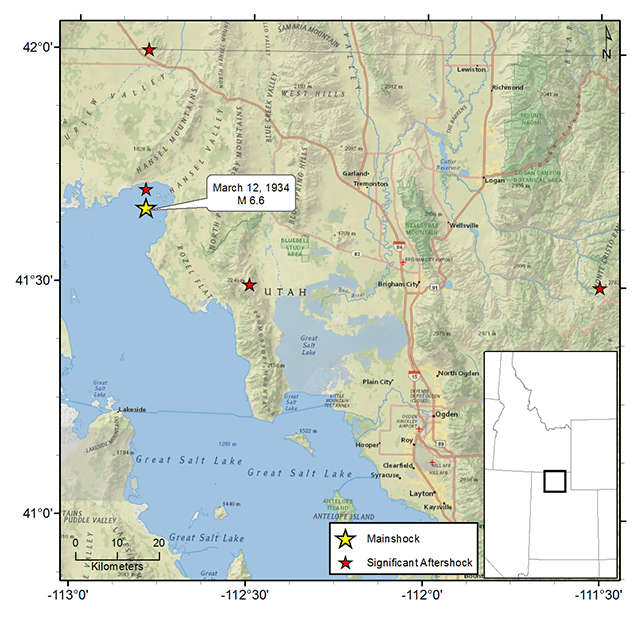March 12, 1934 - Hansel Valley, UT (series) - M 6.6
Believed to be the most severe earthquake in Utah’s recorded history, the 1934 Hansel Valley earthquake was reportedly felt as far west as Elko, Nevada and as far east as Rawlins, Wyoming. Felt reports were also issued from as far north as Boise, Idaho and as far south as Richfield, Utah.
The main shock occurred approximately 30 miles north of the Great Salt Lake at 8:05 a.m. local time. Five significant aftershocks were recorded over a nearly eight-week period from March 12 to May 6, 1934.
Some of the most severe damage was reported in Logan, Utah and surrounding communities. At least two public buildings in the area had to be abandoned. A three-story brick building on the campus of the Utah State Agricultural College was, reportedly, split from top to bottom. In Preston, Idaho, the shaking dislodged a 150-pound capstone from the top of the local high school building, separating the west wall from the rest of the building.
Other reports of damage included falling chimneys, broken windows, cracked walls and falling plaster. Swinging light fixtures were observed during the earthquake. Furniture rocked back and forth or rolled across floors. Dishes and goods fell from shelves and clocks stopped. Near the epicenter, in Snowville, Utah, the water main was broken and out of service for 10 hours. In some locations schools were evacuated and closed, particularly following the first aftershock.
Near the epicenter of the earthquake the appearance of several fissures or cracks in the ground surface were observed. Witnesses reported hearing loud roars as the fissures ruptured. A geologist who later examined the area reported one of the fissures to be about eight miles in length. He found a maximum fissure width of 14 inches, with a maximum drop of the ground on one side measuring 19 inches. Other reports noted a downward displacement of the ground on the east of the larger, predominantly north-south trending fissures.
Phenomena described as sand or mud cones were observed near the epicenter. There were also sightings of new springs and streams changing course. Artesian wells that had been long dry began flowing with water. Other wells, active prior to the earthquake, ceased to flow for several hours.
In many locations, shaking from the earthquake sent people running out of doors. There were also reports of people fainting from fright. In areas of intense shaking, people were unable to stand during the earthquake.
Two deaths were attributed to the earthquake. Ida Atkinson died instantly from a heart attack upon hearing that the shaking she felt was due to an earthquake. Salt Lake City waterworks employee Charles Bithel was injured when a six-foot trench in which he was working at the time of the earthquake caved in. Bithel died from his injuries the following day in a local hospital.
For additional information about this earthquake:
Earthquake Summary Newspaper Articles Photos
Personal Accounts Additional Resources
Intermountain Seismic Belt Historical Earthquake Project
- 1945 Flathead Lake, MT M5.5
- 1952 Bigfork, MT M5.5
- 1935 Helena, MT (series) M6¼
- 1929 Lombard, MT M 5.6
- 1925 Clarkston Valley, MT M 6¾
- 1959 Hebgen Lake, MT M 7.5
- 1975 Yellowstone National Park , WY M 6.1
- 1947 Virginia City, MT M 6¼
- 1945 Central Idaho M 6.0
- 1944 Central Idaho M 6.1
- 1983 Borah Peak, ID (series) M 7.3
